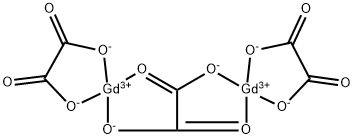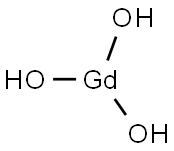GADOLINIUM(III) CHLORIDE HEXAHYDRATE
Synonym(s):Gadolinium trichloride hexahydrate
- CAS NO.:13450-84-5
- Empirical Formula: Cl3GdH2O
- Molecular Weight: 281.62
- MDL number: MFCD00149732
- EINECS: 629-621-0
- SAFETY DATA SHEET (SDS)
- Update Date: 2024-10-23 13:36:13

What is GADOLINIUM(III) CHLORIDE HEXAHYDRATE?
Chemical properties
Faintly grey solid
The Uses of GADOLINIUM(III) CHLORIDE HEXAHYDRATE
Gadolinium(III) chloride hexahydrate can be employed in synthesis and NMR studies of the paramagnetic GdPCTA-[12] and GdPCTA-[13] complexes with possible use as contrast agents for magnetic resonance imaging.
The Uses of GADOLINIUM(III) CHLORIDE HEXAHYDRATE
corrosive toxic moisture sensitive
The Uses of GADOLINIUM(III) CHLORIDE HEXAHYDRATE
Gadolinium(III) chloride hexahydrate is employed in synthesis and NMR studies of the paramagnetic GdPCTA-[12] and GdPCTA-[13] complexes with possible use as contrast agents for magnetic resonance imaging..
What are the applications of Application
Gadolinium (III) chloride hexahydrate is a macrophage inhibitor
Properties of GADOLINIUM(III) CHLORIDE HEXAHYDRATE
| Melting point: | 609℃ |
| Density | 2.42 g/mL at 25 °C(lit.) |
| storage temp. | Inert atmosphere,Room Temperature |
| form | Crystalline Aggregates |
| Specific Gravity | 2.424 |
| color | White |
| Water Solubility | soluble in water. |
| Sensitive | Hygroscopic |
| Merck | 14,4326 |
Safety information for GADOLINIUM(III) CHLORIDE HEXAHYDRATE
| Signal word | Warning |
| Pictogram(s) |
 Exclamation Mark Irritant GHS07 |
| GHS Hazard Statements |
H315:Skin corrosion/irritation H319:Serious eye damage/eye irritation H335:Specific target organ toxicity, single exposure;Respiratory tract irritation |
| Precautionary Statement Codes |
P261:Avoid breathing dust/fume/gas/mist/vapours/spray. P264:Wash hands thoroughly after handling. P264:Wash skin thouroughly after handling. P271:Use only outdoors or in a well-ventilated area. P280:Wear protective gloves/protective clothing/eye protection/face protection. P302+P352:IF ON SKIN: wash with plenty of soap and water. P305+P351+P338:IF IN EYES: Rinse cautiously with water for several minutes. Remove contact lenses, if present and easy to do. Continuerinsing. |
Computed Descriptors for GADOLINIUM(III) CHLORIDE HEXAHYDRATE
New Products
Tert-butyl bis(2-chloroethyl)carbamate (S)-3-Aminobutanenitrile hydrochloride N-Boc-D-alaninol N-BOC-D/L-ALANINOL N-octanoyl benzotriazole 4-Hydrazinobenzoic acid 3,4-Dibenzyloxybenzaldehyde 3-Nitrobenzaldehyde 1,1’-CARBONYLDIIMIDAZOLE R-2-BENZYLOXY PROPIONIC ACID 1,1’-CARBONYLDI (1,2-4 TRIAZOLE) 4-HYDROXY BENZYL ALCOHOL 3-NITRO-2-METHYL ANILINE (2-Hydroxyphenyl)acetonitrile 5-BROMO-2CYANO PYRIDINE 5,6-Dimethoxyindanone 5-broMo-2-chloro-N-cyclopentylpyriMidin-4-aMine 2-(Cyanocyclohexyl)acetic acid 4-methoxy-3,5-dinitropyridine 2-aminopropyl benzoate hydrochloride 1-(4-(aminomethyl)benzyl)urea hydrochloride tert-butyl 4- (ureidomethyl)benzylcarbamate diethyl 2-(2-((tertbutoxycarbonyl)amino) ethyl)malonate Ethyl-2-chloro((4-methoxyphenyl)hydrazono)acetateRelated products of tetrahydrofuran








You may like
-
 Gadolinium(III) chloride hexahydrate, Rare Earth Oxides Content CAS 13450-84-5View Details
Gadolinium(III) chloride hexahydrate, Rare Earth Oxides Content CAS 13450-84-5View Details
13450-84-5 -
 Gadolinium(III) chloride hexahydrate, Rare Earth Oxides Content CAS 13450-84-5View Details
Gadolinium(III) chloride hexahydrate, Rare Earth Oxides Content CAS 13450-84-5View Details
13450-84-5 -
 Gadolinium(III) chloride hexahydrate, Rare Earth Oxides Content CAS 13450-84-5View Details
Gadolinium(III) chloride hexahydrate, Rare Earth Oxides Content CAS 13450-84-5View Details
13450-84-5 -
 Gadolinium(III) chloride hexahydrate, Rare Earth Oxides Content CAS 13450-84-5View Details
Gadolinium(III) chloride hexahydrate, Rare Earth Oxides Content CAS 13450-84-5View Details
13450-84-5 -
 Gadolinium(III) chloride hexahydrate CAS 13450-84-5View Details
Gadolinium(III) chloride hexahydrate CAS 13450-84-5View Details
13450-84-5 -
 Gadolinium(III) chloride hexahydrate CAS 13450-84-5View Details
Gadolinium(III) chloride hexahydrate CAS 13450-84-5View Details
13450-84-5 -
 Gadolinium(III) chloride hexahydrate CAS 13450-84-5View Details
Gadolinium(III) chloride hexahydrate CAS 13450-84-5View Details
13450-84-5 -
 Gadolinium(III) chloride hexahydrate 95.00% CAS 13450-84-5View Details
Gadolinium(III) chloride hexahydrate 95.00% CAS 13450-84-5View Details
13450-84-5
Statement: All products displayed on this website are only used for non medical purposes such as industrial applications or scientific research, and cannot be used for clinical diagnosis or treatment of humans or animals. They are not medicinal or edible.